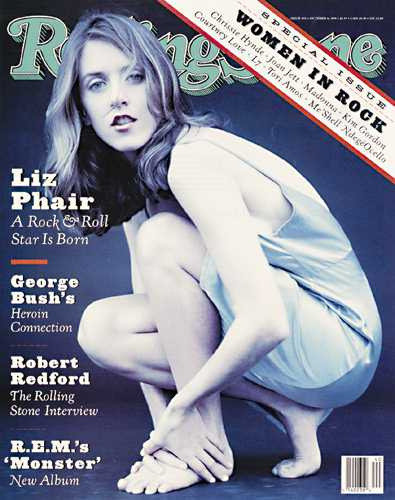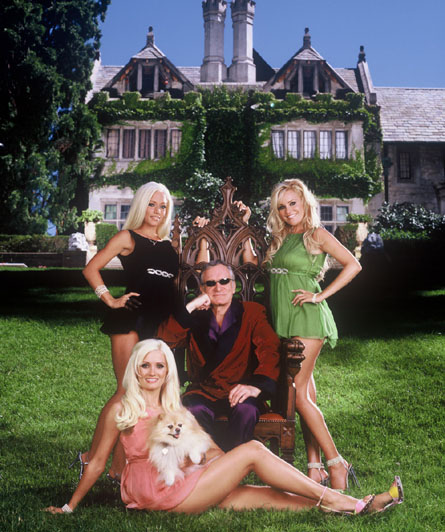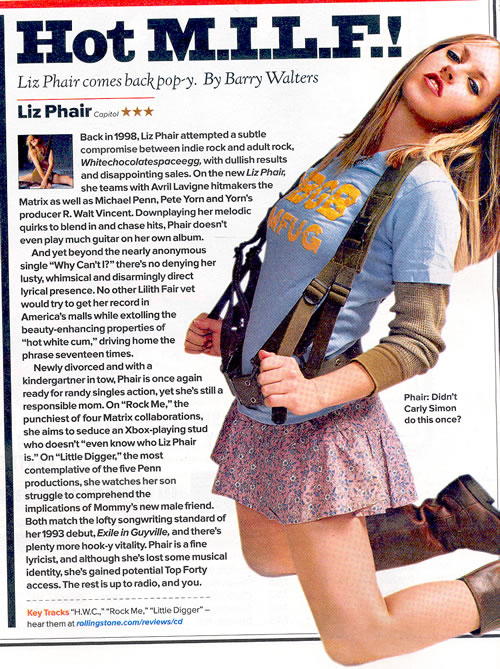Interpreting Exile in Guyville’s Legacy…
Shayla Thiel-Stern / University of Minnesota
Interpreting Exile in Guyville’s Legacy: 15th Anniversary of Liz Phair’s Seminal Album Conjures Questions About the Packaging of Sex, Girl Culture and Feminism

In the summer of 1993, I was too busy hitting the “repeat” button on my CD player for whatever major hit Pearl Jam was cranking on at the time to even notice Liz Phair was quietly singing her way into the consciousness of all my college friends. When all my girlfriends made it back to campus that fall, we were all able to sing along to “Flower” and “Dance of the Seven Veils” before Thursday night outings to the bar – f words, c words and all.
One of the hooks of the album was that it was a song-by-song response to the Rolling Stones’ (brilliant) Exile on Main Street. But never mind that; with the exception of “Happy” on classic rock radio, most of us didn’t know much about the original Exile. Rather, like the rum-and-Cokes we downed before going out, Liz (as we called her) and Guyville were dear friends who our parents probably would not approve of.
Many of my college friends had grown up in the same kind of well-to-do Chicago suburbs as Phair and felt a special connection to this foul-mouthed guitar-wielding waif. But you didn’t have to have anything in common with Liz Phair to revere Exile in Guyville. It was the first time that as 19 and 20-year-old women, we had our own rebellious anthems to sing along with, and it was the first time most of us had a taste of what later became referred to (mostly by male cultural critics) as “do-me feminism” – and it was exhilarating and powerful. This was years before “The Vagina Monologues” and Alanis Morisette’s explicit “You Oughtta Know” made their way into the mainstream, and Guyville was completely original and cool.

Flash forward 15 years to my 35-year-old self, a college professor whose research focuses primarily on girls and media, and who played in a Chicago rock band for a number of years herself in some of the same bars once frequented by Phair. It was with more than a little trepidation that I went out to my local record store to buy the 15th anniversary re-release of Guyville. I still break out the original from time to time, but the new release touted some previously unreleased b-sides and a DVD featuring Phair herself revisiting the early 90s and the Guyville era, which was intriguing. Moreover, something in me still wants to support that part of her career.
So why the trepidation?
Let’s start with the “do-me feminism,” a reaction to anti-pornography feminism that suggests feminists can also embrace sexuality, that some have reappropriated to symbolize women’s growing love of sex and sexiness. Back in 1993, grunge was god and my peers and I lived in sexless baggy flannels, cut-offs over long underwear, and Doc Martens. We wouldn’t have dreamed of micro-minis and half-shirts that you see on a lot of college-aged women today, and the stars we saw on TV weren’t dressing that way either. The sexiest youth-oriented show on television was Beverly Hills 90210, which is quaint and tame by today’s standards (case in point: a recent preview of the CW’s Gossip Girl featured two of the heroines and classmates in various states of undress and a flash to the text-style acronym/swear, “OMFG!”).
As the decade progressed, the mediated messages about female sexual empowerment shifted from targeting young women in their 20s to young girls in their teens to tweens and younger, and the messages were no longer necessarily about sexuality but instead about sexiness. Disney characters like “Pocahontas” raised eyebrows in 1995, but eventually were overtaken in tween popularity by Bratz dolls. Today, The Girls Next Door, a reality show featuring Hugh Hefners’ three Playboy Bunny girlfriends, is very popular with young women and girls under 18. ((World Screen Weekly September 6, 2007.) In music, the mediated pro-sexuality messages also skewed younger: 17-year-old Britney Spears’ iconic sexy-schoolgirl video for her hit, “Baby, One More Time,” was only the start of it.

As a feminist scholar, it is sometimes difficult to reconcile my own pro-sex feminist views with my disdain for stereotypical patriarchal representations of young women’s sexuality. (And as a music snob, it’s difficult to link early Phair to Spears at all.) However, to paraphrase the old cigarette ads, the re-release of Guyville serves as a sad reminder of some backward cultural movement with regard to the cultural representations of girls and women. To me, the Guyville era began with young women taking ownership of their sexuality in terms once deemed unladylike; now, far too often, young women instead take part in a heteronormative male fantasy in which they have no ownership at all. The new female music industry darlings – Rihanna and The Pussy Cat Dolls, for example — are all about looking hot and using cute double-entendre lyrics instead of just calling it fucking, Phair style.
The legacy of Guyville – and women rockers in general — are almost nowhere to be found in this manufactured world of pop we live in today. Feist, Amy Winehouse, and Lily Allen have found success and credibility in this world, but none have impacted culture – and specifically, girl culture – like Liz Phair did in 1993. Furthermore, we have to question what Liz hath wrought: Through her low-fi rocking out and embracing her sexuality in confessional, intelligent post-feminist lyrics, did she also fuel this new, troubling phase of women and girls in music? Did her raw style, her words and music, give countless recording execs the idea that women overtly embracing their sexuality – in the “do-me feminist” style – would sell across gender and age groups? The idea that sexual empowerment could be used as a marketing tool for girls is troubling, but it’s not necessarily surprising given the way the media industries work.

This brings up an interesting point about the “legacy” of Guyville. The following years showed in so many ways, that even Liz Phair, Ms. Indie-rocker herself, was not immune to slick record company packaging and marketing. When her third album, whitechocolatespaceegg, was released in 1998 most reviews mentioned she had a baby and that she wasn’t swearing or talking about sex so much (after all, a self-proclaimed “blowjob queen” could not also be portrayed as a newlywed mommy). Phair’s next album, released in 2003, featured her on the cover, naked, pornstar-like, straddling her phallic guitar, and all the marketing materials released with it (and all the ensuing articles and reviews about it) cast her as a recently-divorced “milf,” feeling sexually empowered again. This older version of sexual empowerment showed through a completely un-ironic, un-funny song about hooking up with an X-Box playing college kid, and this time, she cranked out a bonafide hit, “Why Can’t I…?” which was co-written with The Matrix, a song-writing team that penned hits for the likes of Avril Lavigne and Hillary Duff. Later, her very non-indie-rock-ish track “Extraordinary” would be heard as a background on all kinds of TV commercials.
In other words, it seemed through the years that Liz Phair was less and less the sexually empowered post-feminist who rocked my world, and the worlds of so many other young women in the early 90s, and more and more another manufactured pop star packaged and sold by a male-dominated recording industry.

However, another revelation has become increasingly clear to me over the past 15 years: Exile in Guyville’s Phair was also manufactured and packaged – and even as a “do-me feminist,” which was also clever corporate marketing since Phair doesn’t bill herself that way, she was also sold as an indie-rock guy’s dream girl. My female contemporaries look back on Guyville as transforming, and my male contemporaries do the same. They respect her music and genius, but a lot of them will also bring up the fact that she was a totally cool, hot babe. They’ll bring up the Rolling Stone cover she posed for in 1994 and also remind me that the very tip of her nipple shows in the shot on the cover Guyville, and that it was designed by former Urge Overkill frontman Nash Kato.
Which brings me back to the special re-release of Exile in Guyville. We learn in the DVD accompanying the re-release – a lengthy, low-fi documentary seemingly shot by Phair herself – that Kato was the inspiration for a lot of the songs on the album. She includes long conversational interviews with old bandmates, producers, record company guys, movie and rock star friends of hers from the Chicago days (all men, even though there certainly were a few women in the Chicago rock scene in the early 1990s – D’arcy Wretzky and Veruca Salt, for example, who I would liked to have heard from). In the interviews, the various guys regale Phair with tales of recording and promoting Guyville – how she used to try to bum beers from hipsters at Chicago’s Rainbow club, how she refused to make certain changes her producers suggested – and Phair often replies, “I did that? I was like that?” She seems shocked by her own audacity and gumption.
[youtube]http://www.youtube.com/watch?v=yDpUJjVfpOU[/youtube]
It strikes me as a little bit sad that this potential feminist icon has no idea about her audacious brilliance as a younger woman nor does she realize exactly the impact she’s had on other women. This point is further emphasized at the end of the DVD, which does feature a number of women talking specifically about how they were affected by Guyville – from personal stories about ex-boyfriends to the same kind of stories about getting ready to hit the town with girlfriends. It’s impossible to tell whether Phair even conducts these interviews because, unlike the other parts of the video, she does not comment or participate in the conversation, and women don’t appear in the video until after a point when producer Steve Albini comments that the album meant so much to girls at that time.
Despite all this, and in spite of Phair’s more current representation in mainstream music, Guyville represents a cultural turning point – not only for young women who loved rock but also for girl culture itself. The album made it OK for us (girls) to talk explicitly about sexuality in terms that only guys were allowed to use, and it made it fine to acknowledge both the vulnerability as well as the fun and vulgar aspects of sexuality, even if it was in the form of singing along. That singing along sparked our own audacity and gumption, and I think in many ways shocked a lot of us into better understanding gender politics, sexuality, and ultimately, feminism. Not the packaged kind of “do-me feminism” marketed today, but the real thing. That particular aspect of the album’s legacy – and the memories of my college friends jamming out to “Liz” – make me most thankful for the opportunity to revisit Guyville.
Image Credits:
1. Liz Phair’s Exile in Guyville
2. Liz Phair on the cover of Rolling Stone
3. Girls Next Door
4. Milf article
5. Last Phair album
Please feel free to comment.
Overall I really enjoyed your column, particularly the personal connections to the album and the culture surrounding it. In terms of observations, I’m uncertain how we (scholars) can define “authentic” sexual empowerment and what authentic sexual empowerment would look like exactly. While I agree that a considerable amount of female musicians are sexually exploited and manufactured as sexual objects, I still hesitate to label anything or anyone as a model of “authentic” feminism (“do-me” feminism or any other kind). While Rihanna may suggest sex (without explicatives and explicit language) and seemingly lack ownership of her sexuality, I find it fascinating that she refuses to let the music industry completely control her image – in particular the length of her hair. Though this aspect might seem insignificant in relation to Guyville and Phair’s persona in the 90s, I think it is necessary to address how the music industry has changed since Guyville and how these changes have impacted female musicians in particular. Overall, I feel it’s imperative to consider how female musicians are adapting to and subverting the industry from within rather than lament about how they fail to compare to female musicians of the past (even the past decade).
This brings me to reception studies and the importance of audiences and fans. What I most enjoyed about your article is your discussion on Liz Phair’s (and the Guyville album’s) impact on females and female musicians. Throughout the article you provide reasons to discredit Phair’s “authenticity” and subversiveness (her recent commericial sucess, the ways she was marketed by men within the industry, and her heterosexual sex appeal). However, you seem to suggest that despite these factors, Liz Phair and the Guyville album will always be positively associated with your personal notions of feminism and sexual empowerment. I can’t help but wonder how girls today are interpreting and reappropriating the very images and music that (feminist) scholars and social critics deem regressive. How depsite possible regrssive aspects of their music and/or persona, girls still find something empowering and even feminist when theywatch and listen to Rihanna, The Pussycat Dolls, and yes, even the Playboy Bunnies.
Thanks for the article, Shayla — I too was greatly impacted by this album. I literally listened to this album every day for six months after I bought it and still know all the words to every song, backwards and forwards. I was a brainy, sexually frustrated teenage girl in a small town, so this album, in many ways, got me through high school and, later, would come to inform my personal and political investment in gender and popular music. So I was really excited to read this piece.
I also admit to similar feelings of trepidation about this repackaging — I haven’t bought the anniversary edition yet — as well as the evolution of Phair’s career and the sexual politics of postfeminism, post-Guyville. I’m also curious as to how this deluxe reissue of an “indie masterwork” sit amid several others of late and reflect a trend of re-remembering the history of albums that were not operating within mainstream music’s climate when they were first released? Though I read about this album when I was ten (when it first came out), I lived in a small rural town that didn’t have a record store that distributed it until the town over opened a Barnes and Noble when I was sixteen. (I was too timid at ten to buy it with my allowance amid all the hubbub around its sexually explicit content and waited until my sixteenth birthday six years after its release — thus my coming to the album is its own practice of historical revision).
Furthermore, I’m curious about how these repackaged albums are informed by current industrial practices in the music business. How might this album now be available to people who wouldn’t have been exposed to it fifteen years ago, and what are the stakes of it being re-released in an entirely different, overwhelmingly corporate, music climate? What is to be made of the change in distribution practices that first allowed Exile in Guyville to be released independently on Matador, only to be repackaged on Dave Matthews’s ATO Records (which is distributed by Sony)? How do the clearly capitalist motives of encouraging old fans to rebuy their records and new fans to purchase souped-up, repackaged albums impede the artistic side of the music industry and warp the original historic contexts around these albums?
(Note: Jessica Hopper wrote a really interesting article for the Chicago Reader that raised many of these issues in her review of Sonic Youth’s repackaged Daydream Nation.
Finally, I wonder what is to made of the gender politics at work in the critical responses to these repackagings. As there have been several in the past few years, I’ve followed closely the ratings that the staff at Pitchforkmedia have given these albums, and I find it disconcerting (though, unfortunately, unsurprising) that the perfect scores (10 out of 10) go to the albums by all-male bands like the Stooges, Television and Pavement, yet equally seminal and influential albums by female artists (i.e., The Slits’ Cut, Patti Smith’s Horses, and Liz Phair’s Exile in Guyville) are always just shy of perfection with condescending scores like 9.4. What does a woman have to do to cut a “perfect” album?
I share k’s uneasiness regarding authentic and inauthentic kinds of empowerment and feminism. Additionally, I’m wondering how “do-me feminism” might differ from Erica Jong’s ’70s-era dream of the zipless fuck. I worry about the dangers of shaking our heads at “kids these days” as if somehow, we, 5, 10, or 20 years earlier did things much better.
When I was 15 years old, I lost my virginity to my 16 year old girlfriend. She put on Liz Phair’s “Shatter” afterward, and it was about the time in the lyrics when “I don’t know if I could fly a plane/Well enough to tailspin out your name” was sung that I fell in love with her.
About eight months later, when we broke up, I gave her a tape with “Divorce Song” on it… a 16 year old’s heartfelt plea to the first woman he ever loved about what we were losing, but what we would forever have.
Pingback: Katy Perry: Ripoff Artist « Flotsam on the Stream of Pop Consciousness
Pingback: Records that made me a feminist, by Alyx « Feminist Music Geek
Pingback: voxygen.net » Random Musings
It’s actually very complicated in this active life to listen news on Television, so I only use the web for that purpose, and obtain the newest news.
Thank you for writing this. I wasn’t a huge Liz Phair devotee at the time when EIG was released but I am of your era and was a fan of her contemporaries. By all accounts I should have been a huge fan but there was always something that stopped me from really loving her. I admired her music. I think she’s talented. I think I’d be into her now and I’ll give her another go.
I remember really feeling that she was one of the only women musicians of the era to straddle that fine line between wielding the axe and also being non-threatening enough to be a sexual object and I don’t know why that fact was so admired (boys were allowed to admire her AND lust after her… whoop di doo). I too was studying subjects with a strong feminist bent at the time and this dichotomy somehow didn’t sit well with me. The fact that it didn’t sit well with me also confused me because at the core I support female sexual empowerment, which I suppose was one of those phrases bandied around at that time. I guess, when it comes down to it I was more interested with female rock stars who were not afraid to be ugly – I suppose like many male rock stars often are.. and that’s okay. Unfortunately some of those artists were also supremely fucked up (namely Courtney Love) – so perhaps that doesn’t work either. haha.